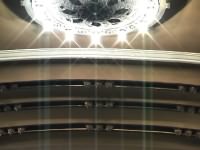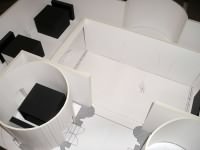The selection process of the Hungarian representative of this year’s Venice Biennale has generated intensive debates in the Hungarian art scene. The jury convoked by the Commissioner (the director of the Kunsthalle) has already announced Csaba Nemes’s project, „Remake” as the winner of the open call when the decision was cancelled adducing a formal defect in the application (a curator duo instead of one as specified in the call). The newly announced winner is „Kultur und Freizeit” by Andreas Fogarasi. While the procedure has raised numerous questions concerning the functionality of the decision making system, the projects themselves were overshadowed during the discussions and debates. It is this “blidspot” that we intend to remedy here. (N. E., B. B.)
Nikolett Erőss : What do you think of the Venice Biennale, about the demands for national representation and the role schemes that are set by these demands?
Andreas Fogarasi: The Venice Biennale is certainly still among the few most important venues to see art. It is a beautiful and bucolic venue. Most projects have been carefully prepared, there is space for the works and the viewers, and there is this somewhat unreal connection to a city that is a much more powerful theme park than an art event can ever become.
The national pavilions are in that context as problematic as they are interesting. They are a miniature museum of architectural styles and aspirations throughout the 20th century that is well worth a visit at non-Biennale times.
With all this in mind, one must not forget about the shortcomings of such an event and question the tradition of national representation as well as its universalistic attitude. Works that managed to do this while maintaining an artistic autonomy that goes beyond the immediate event have been very influential for me when thinking about the context of this exhibition. I would name here Hans Haacke’s project in the German Pavilion 1993, also the Austrian Pavilion in that year with Gerwald Rockenschaub, Christian Philipp Müller and Andrea Fraser, and certainly Little Warsaw’s 2003 project that in very different ways asked questions about history, context and form of cultural representation.
But, in any case, it is quite strange to be exhibiting here. I had specific ideas as to the possible venues where this work could be shown – some of these are included in the texts of the video: a gallery, a squatted house , a kunsthall e, a conference centres. I had not thought of an international biennial, although, especially in Venice, there are many motifs and situations which are very productive for the perception of the work: the tension between the internationality and universality, and the representation of national culture, the extra-territorial, autonomous spaces in the park, the Hungarian Pavilion’s architecture laden with national motifs, and so on, make this an ideal venue for presenting this particular work.
When did cultural centres appear on the horizon of your personal and professional life, and why did you start working with them?
I became involved with these type of cultural centres through Tibor Várnagy, when, in 2004, I exhibited at the Liget Gallery, run by the Cserepesház of Zugló. I was interested in this setup, and Tibor told me a lot about the history of these cultural centres. All this stayed with me, and then, when a year later I had the opportunity to stay in Budapest for a longer period, I became engaged with the theme in a more direct manner; I began doing some research and looking at these buildings.
Did you have any earlier, personal experiences regarding cultural centres?
Not really. There are some similar things in Austria, but not in such high numbers and of such significance. Of course, there are some similar models in most of the former socialist countries. And as a matter of fact, they can also be found in France in the format initiated by André Malraux – the Maison de la Culture et Communication – which is built on the idea of the decentralisation of culture.
How, based on what, did you choose the centres where you did your shooting and how did you prepare for this work?
I had help from a number of people in choosing the centres. The architectural aspect is especially important for me and is given the most emphasis in the films. In addition, the history of the centres and the urban context are also important, as well as telling the story of these buildings not only as regards the socialist period, for I wanted to map out the whole of the 20th century. I encountered very varied situations: in some cases, I was able to find out a lot about the buildings during the visits, in others, the door was opened to me to look around and that was it, I had to get my information elsewhere.
You have already dealt with the various manifestations of the culture industry in urban environments in some of your earlier work. How can the transitory situation of Budapest’s cultural centres, and their ability – or lack thereof – to adapt to the changed demands be brought into connection with these previous works?
I have long been interested in different places and forms of culture. The significance and manifestations of culture – the concepts of culture – have gone through a great transformation. It is also important to notice whose interests culture represents, and how it can turn into an empty, white screen for these interests. Culture has a crucial role in the transformation of cities and regions, in their search for new identities after Fordism and industrialisation. In the past, I have looked at how large, representative museum projects can add to the touristic value of places, how the cultural industry is shaped in accordance with economic interests. In this context, the model that cultural centres represented is noteworthy; they were places that served specific political agendas and which, along with the annihilation of these political agendas, lost the framework into which they fit, but could not find a new one to take its place.
Your project, „Kultur und Freizeit” (Culture and Leisure) approaches the topic of cultural centres in a rather reticent manner, mostly from the perspective of architecture, urban (public) space / public building. You lead viewers through the locations and introduce these communal spaces with an interpretation-free and reserved attention that, at the same time, remains sensitive to detail, all the while allowing the users of, and activities in, these spaces to remain, for the most part, invisible. This approach delineates – and also recreates in an exhibition environment – the unique vacuum in which the vast majority of these places (founded earlier) came to dwell by the nineties. While your vantage point is clearly not that of a cultural anthropologist or sociologist, it remains a question for me whether the history / social role of cultural centres can be separated from introducing them. How can these contexts nevertheless manifest at the exhibition, is it your aim that they do?
Architecture can say a lot about the reality – but also about the utopias – of a society. What stood out for me about these cultural centres was that these buildings are in part quite representative and how their architecture – which is of a high quality – indicates the significance of these places. My films, however are not documentaries, I indeed provide little information and present almost fictive situations. This way, everyone can react differently to this lack of information and can fill the absence in various ways. While the Hungarian audience has more knowledge on this subject, it also cradles more myths. In an international context, there may be some who will want to acquire more information about the cultural centres of Budapest. Some, on the other hand, will make a connection with other narratives, places, the changed role and decentralisation of culture today. The conviction that people do not necessarily need to be “brought into the picture” in order to become involved with their presence characterises a number of my works: we can see the spaces they move around in, the marks of use and a certain type of potentiality, the possibility of usage of space. For me, the most interesting thing is not what is presently happening in the centres, but what happened in the past few decades, and what could happen. Had I made an attempt to introduce the people, exotisation would have been difficult to avoid. If the films do one thing, it is that they aesthetise the buildings, which was, in fact, my aim. I did not want to make my film about the bad condition and state of neglect these buildings are in, because that, for the most part, would not reflect the truth.
The works use captions and sound inserts in a quite cryptic manner. These, beside the fact that they appear in various languages, also seem to represent varied levels of meaning. In conjunction with the Gutenberg Cultural Centre, the captions describe temporally consecutive functions and roles, and, in the case of MOM, one sooner or later figures out that the captions are actually film titles. What was you intention by this?
Yes, with MOM, these titles belong to the films that have been playing at the Multiplex Cinema of the MOM Centre. This complex is a shopping and recreational centre which has been built in the place of the former MOM factory. Thus, the cultural centre of the factory is now adjacent to this, thereby bringing a number of cultural interests into opposition. The texts that accompany the images work in several layers. First, they provide the most basic information about the buildings and their function. Thus they soon gain some authority that I take up and play with, inserting personal thoughts, self-referential statements, serial wordplays or simply conflicting information, complicating the process of didactic intermediation. There are several text parts that challenge the notion of singular historic events, when for example the year of the erection of the Cultural Centre of Óbuda is complemented with the years of its use until today. It was important to find a common visual layer for all these texts, which was the intertitle – also one of the few overtly cinematic references in the films.
What role do you intend to give to the two-part black box in which the individual video pieces are shown? Is the box itself an installation or a coherent part of the work?
The box is part of the work. I feel that with this box and the size of the projection the work has found its form and space. The boxes place the viewer in the same space with the image and the film, while the gaps between the projection part and the viewer’s part also provide an outward view. These are autonomous sculptures, but also stage sets, which have a different direction from that of watching the films. The installation has ideal vantage points – which connects with certain conventions of architectural representation that are also important in films – and there are also some “backstage” situations.
To what extent does this approach take into consideration the space of Venice’s Hungarian Pavilion, which is rather restricted and often very challenging for the exhibitor? Can we talk of an elimination of unique spatial characteristics or is it more of an open confrontation?
We can definitely talk about a clash. The idea of the boxes preceded the Biennale, so these two notions of space are certainly in confrontation with each other. This will lead to spatial situations that are sometimes perfectly staged – like the autonomous minimalist sculpture hovering in space – and sometimes there will be odd surplus spaces that are not so easy to decipher and to walk through; corners or gaps which are just wide enough to walk around or pass through, but still take away the automated security that a classical exhibition space like the Hungarian Pavilion usually gives the viewer. It is these undecided architectural spaces that I like to create in my installations and that are also a reason for my interest in the undecided political backgrounds of buildings and institutions.
Will there be anything besides the boxes in the space of the pavilion?
Weaving together the space and the boxes will be what requires the real effort. This is still in progress and the means and the outcome of it will be something “more” than the boxes, whatever form it will take.
What plans do you have with the work prior to the opening of the Venice Biennale? How many videos have you completed? Are you planning any new shoots or other complements?
I first made a single film, which I presented in Berlin last September, and then finished three more. I am making new ones for Venice and would later like to continue the work. But the films will hardly be influenced by the Venetian context, as they are autonomous.
What publication are you planning to do?
The publication, on which I am working together with Katalin Tímár, will not be a catalogue, but more of a book which will feature texts not so much dealing directly with the artwork but more with the changing situation of culture, the difference between popular culture and mass culture, the relationship between work and free time, and the places of culture and counterculture. We are thinking in terms of a book that points beyond the exhibition and will serve as reference on topics that my work addresses.
What is the significance of the Venice Biennale from the perspective of your own art practice, what are your expectations?
“I’m thrilled; it’s a great honour and a fantastic challenge. I’m looking forward to it,” says Tracey Emin, England’s 2007 representative, and of course I feel similarly. I would only add two equally banal things. Firstly, in this situation, a lot more people, arriving from various situations and backgrounds, will see my work than on any previous, or perhaps future, occasion. The other thing is that I do not have a Hungarian passport, I was born and I am still living in Austria. This puts me in a very special situation that already frees the project from a lot of the constraints that I sketched out above, since my person and the work I am showing have very strong bonds to Hungary, but this is not formalised in any way. I think it was a very brave decision to send me to Venice for Hungary and I think on an international level this will be recognised positively.
Interviewed by: Nikolett Erőss
Translated by: Zsófia Rudnay


